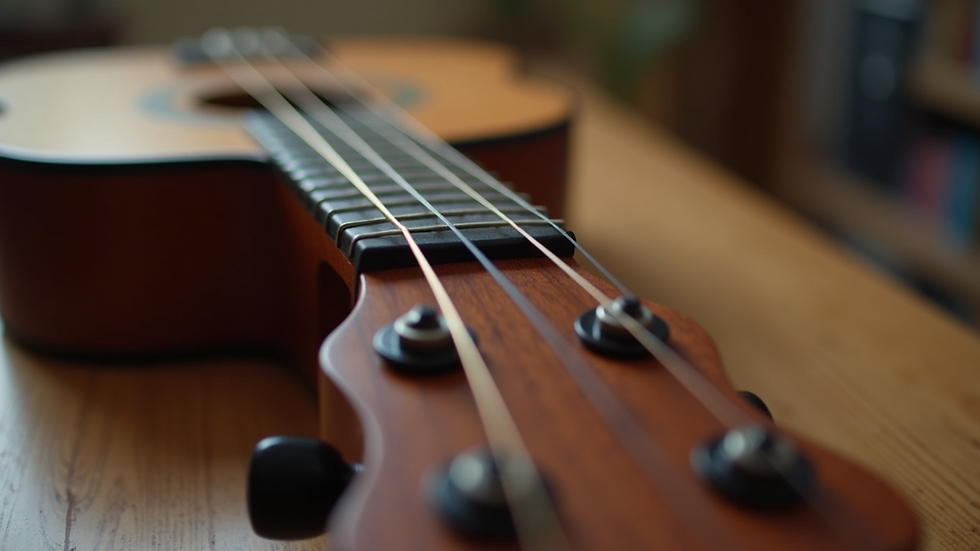Mastering GCEA Tuning for Ukulele
- Thomas Powell
- 2 days ago
- 4 min read
If you’ve just picked up a ukulele or are looking to improve your playing, one of the first things you’ll want to master is tuning. Getting your ukulele perfectly in tune makes all the difference to your sound and enjoyment. Today, I’m going to share some straightforward ukulele tuning tips that will help you confidently tune your instrument to the popular GCEA tuning. Whether you’re a parent, grandparent, carer, school teacher, or music educator, these tips will make tuning easy and fun!

Why Tuning Your Ukulele Matters
Tuning your ukulele correctly is the foundation of great sound. When your strings are in tune, chords ring out clearly, melodies sing, and your playing feels rewarding. If your ukulele is out of tune, even the best strumming won’t sound right.
Tuning also helps you develop your ear. Over time, you’ll start recognising when a string sounds off and be able to fix it quickly. This skill is especially useful if you’re teaching others or playing in a group.
Here’s a quick tip: tune your ukulele every time before you play. It only takes a few minutes and will save you frustration later.
Ukulele Tuning Tips to Get You Started
Let’s dive into some practical tips to get your ukulele tuned perfectly:
Use a Tuner
The easiest way to tune is with an electronic tuner. Clip-on tuners are great because they pick up vibrations directly from the ukulele, so you can tune even in noisy environments. Simply pluck a string and adjust the tuning peg until the tuner shows the correct note.
Know Your Notes
The standard ukulele tuning is G, C, E, A from the top string (closest to your face) to the bottom string. Remember this order: G (4th string), C (3rd string), E (2nd string), A (1st string). Many people use the rhyme "Green Cats Eat Ants!"
Tune Slowly and Carefully
Turn the tuning pegs slowly. Tightening the string raises the pitch, loosening lowers it. Small adjustments make a big difference.
Tune Up to the Note
If your string is flat (too low), tune it slightly above the note and then bring it down to the correct pitch. This helps keep the string tension stable.
Check Your Work
After tuning all strings, play a few chords to check if they sound right. If something sounds off, re-tune as needed.
Practice Regularly
The more you tune, the better you’ll get at recognising notes and adjusting your ukulele quickly.
Why is the Ukulele Tuned in GCEA?
You might wonder why the ukulele is tuned specifically to GCEA. This tuning is traditional and has several benefits:
Easy Chord Shapes
The GCEA tuning allows for simple chord fingerings that are easy to learn and play. This is perfect for beginners and children.
Bright, Cheerful Sound
The tuning produces a bright, happy tone that suits the ukulele’s light and playful character.
Versatility
GCEA tuning works well for many music styles, from Hawaiian and folk to pop and jazz.
Re-entrant Tuning
The G string is tuned higher than the C string, which gives the ukulele its distinctive sound. This re-entrant tuning adds a lovely shimmer to your playing.
Understanding this tuning helps you appreciate the instrument more and makes learning songs easier.

How to Tune Your Ukulele Without a Tuner
Sometimes you might not have a tuner handy. No worries! Here are some ways to tune your ukulele by ear:
Use a Piano or Keyboard
Match each ukulele string to the corresponding piano note: G, C, E, A. Play the piano note and adjust your string to match the pitch.
Use a Tuning App
Many free apps can help you tune by listening to your strings and showing you the note.
Tune to Another Ukulele
If you have a friend with a tuned ukulele, you can match your strings to theirs.
Use a Reference Pitch
If you know the pitch of one string (usually the C string), you can tune the others relative to it by matching the intervals.
These methods take a bit more practice but are great skills to develop.
Keeping Your Ukulele in Tune Longer
Once your ukulele is tuned, you want it to stay that way. Here are some tips to keep your instrument sounding great:
Stretch Your Strings
After tuning, gently pull each string away from the fretboard a few times. This helps the strings settle and stay in tune.
Tune Regularly
Even if you’re not playing, check your tuning every few days.
Store Properly
Keep your ukulele in a case or on a stand away from extreme temperatures and humidity.
Use Quality Strings
Good strings hold tuning better and sound nicer.
Avoid Over-tightening
Don’t crank the tuning pegs too hard. This can break strings and damage your ukulele.
By following these simple steps, your ukulele will be ready to play whenever you are.
Ready to Tune Your Ukulele Like a Pro?
Tuning your ukulele doesn’t have to be tricky. With these ukulele tuning tips, you’ll be able to get your instrument sounding beautiful in no time. Remember, practice makes perfect, and tuning is a skill that improves with use.
If you want to explore more about ukulele tuning and playing, check out this helpful resource on ukulele gcea tuning. It’s packed with useful guides and support to help you on your musical journey.
Happy strumming and tuning! Your ukulele adventure is just beginning, and I’m excited for you to enjoy every note.
Keep your ukulele tuned, your fingers nimble, and your heart full of music!



Comments